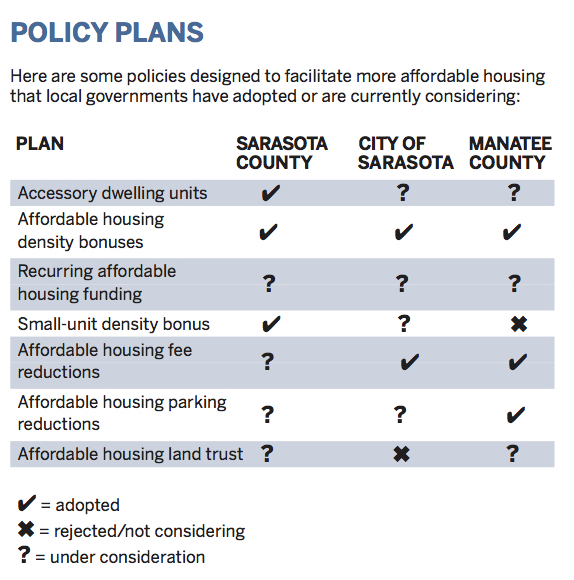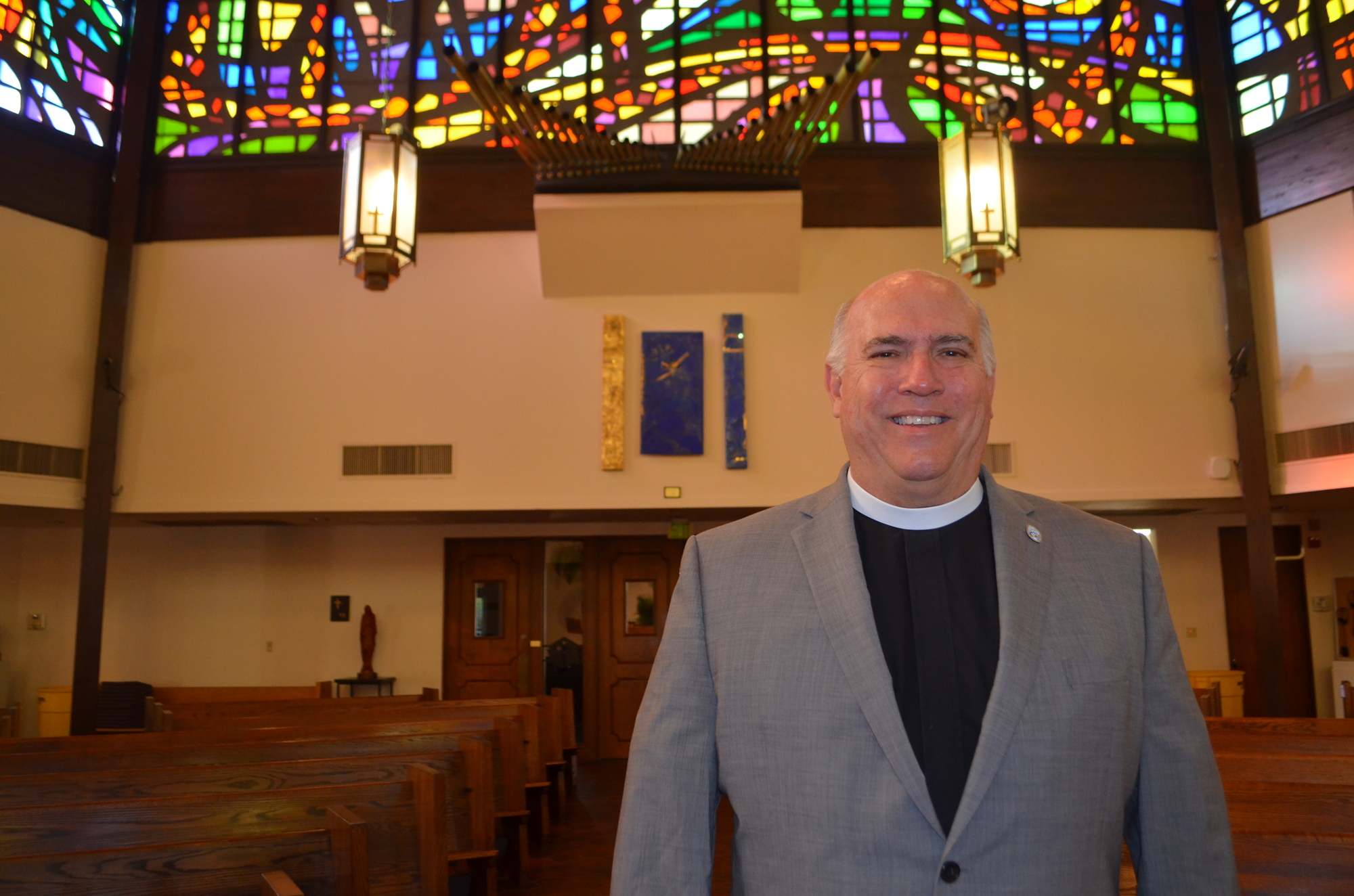- December 26, 2024
-
-
Loading

Loading

Editor’s note: This is the second of two installments examining the affordable housing situations in Sarasota and Manatee counties. Last week, we examined the problem. This week: the potential solutions.
Local officials acknowledge government policies have failed to result in an adequate supply of affordable housing in the Sarasota-Manatee area today. Now they say they’re determined to make up for the mistakes of the past.
This year, in Sarasota County, the County Commission authorized a series of new provisions that make it easier to build smaller units, including an ordinance allowing accessory dwelling units in many single-family neighborhoods.
In Manatee County, the government will pay impact fees for affordable developments and has discussed creating a land trust, which could be a source of land for builders to facilitate the production of affordable homes.
In the city of Sarasota, officials created new affordability incentives in the Rosemary District and are drafting plans for high-density zoning categories with affordable housing requirements. In October, commissioners moved toward establishing a new affordable housing advisory board.
Throughout the region, officials are taking a multifaceted approach to addressing a problem that has built up over the course of decades. They’ve heard guidance from local stakeholders and external experts who say a broad strategy for facilitating the production of more affordable housing is necessary.
“The thing about affordable housing is there’s no silver bullet,” said William Russell, the president and CEO of the Sarasota Housing Authority. “It’s more of a toolbox approach, so the more policies and incentives we can keep throwing at it, the better.”

Among participants in these policy conversations, there’s a belief there’s been a tangible shift in the approach leaders are taking to the issue. For more than a year, officials have not let the issue fade from their list of priorities.
Still, a question remains: Will this strategy be effective and aggressive enough to make a meaningful difference?
“I think they should be pretty ambitious, just because of the need,” Russell said. “Everything I hear tells me it’s pretty acute, so I think the longer we wait, the worse it’s going to get.”
Representatives for Sarasota United for Responsibility and Equity have appeared at county and city meetings this year to advocate for one policy officials haven’t aggressively advanced: setting up a recurring source of funding for affordable housing.
SURE, a coalition of 19 Sarasota churches, has identified affordable housing as a priority issue for creating a more equitable community. The group is happy to see new policies advance, but it’s worried those policies will be insufficient without an infusion of cash to make it easier to produce affordable housing.
The group asked Sarasota officials to invest $15 million into a housing opportunity fund, to be followed by annual payments from county and city budgets.

That’s a challenge for local governments with limited untapped resources. They have already spent and earmarked some money for affordable housing: Sarasota County has allocated more than $21 million toward housing in the past five years. Manatee has budgeted $1.2 million this year and has an additional $1.5 million in reserves. The city of Sarasota allocated $500,000 toward affordable housing on city-owned properties, and the county contributed an additional $1 million. But commissioners have not taken up SURE’s request to allocate set resources toward the issue year-in, year-out.
“The thing that makes this piece kind of a third rail is that it takes revenue,” said the Rev. Wayne Farrell, of St. Boniface Episcopal Church and a member of SURE. “That’s where we’re looking for courage from our elected leaders.”

Officials recognize that cost for builders is a major impediment to the construction of new affordable units. Developers, such as Pat Neal, the president and CEO of Neal Communities, also take issue with the prospect of going through public review processes that can last months with no guarantee a project will be deemed acceptable.
In 2018, Sarasota County’s Affordable Housing Advisory Committee listed fast-tracking approvals and reducing or waiving impact fees as top recommended strategies for creating affordable housing. The county is considering steering funds from sold properties toward affordable housing projects. The city of Sarasota has created a process to waive transportation impact fees for affordable projects.
Manatee County goes one step further by offering to pay up to $500,000 in impact fees for affordable projects. Although Sarasota officials say they’re limited in their ability to waive impact fees, builders say Manatee County officials have done a better job of reducing the barriers to entry for an affordable project.
Even after the city agreed to waive some fees, in 2018 the late developer Harvey Vengroff abandoned plans to build about 200 workforce housing units near downtown Sarasota. Vengroff bemoaned regulations and fees in explaining his decision. Today, his son Mark Vengroff said other communities — including Manatee — outpace Sarasota when facilitating affordable projects.
“If I have an opportunity in Sarasota, and then I get an opportunity in Bradenton, I’m more likely to take the opportunity in Bradenton, if I had to choose, just because it’s so much easier to get things done,” Vengroff said.
For projects in which 10% or more of the units are affordable, Manatee County has a “housing rapid-response team” to fast-track developments through applicable permitting procedures. Projects featuring 25% affordable units can apply for assistance from the county’s tree-protection trust fund to meet landscaping requirements.
Sarasota-based affordable housing developer Donald Paxton has an idea on how to get more affordable housing built in the region: Don’t restrict the areas where affordable projects are viable.
Paxton said officials have historically had a misguided strategy for affordable housing. They look for a place where nobody would object to the units being built, and they allow for denser construction there. Generally, that means the sites available to an affordable housing developer haven’t been the most attractive.
“It’s usually in the worst part of town, no access to good jobs, no access to good schools,” Paxton said. “That’s not where good low-income housing gets built.”
Paxton thinks removing restrictions to allow higher-density housing in more desirable neighborhoods would result in a better supply throughout the community. City of Sarasota Planning Director Steve Cover agreed that a balanced distribution of housing is desirable.
“The more you can spread out affordable housing in the city and the community, the better off things are,” Cover said.
But the prospect of allowing higher-density construction in established neighborhoods with predominantly single-family homes can garner pushback from concerned residents. Even advocates for more housing, such as Sarasota City Commissioner Hagen Brody, are reticent to change neighborhoods in pursuit of more affordable housing.
“The biggest thing for me is putting people at ease that I want to protect the single-family neighborhoods that we have,” Brody said. “I think looking at the corridors and the major roads that surround them, that is our opportunity to make a difference.”
As they strategize how to induce the production of more affordable housing, officials must deal with a recently passed state law that prohibits the practice of “inclusionary zoning” — mandating affordable housing in residential projects — unless a developer is compensated for the expenses associated with the regulations.
That has led to an emphasis on incentives rather than mandates. In Manatee County, projects incorporating a 25% affordability ratio are eligible to request density bonuses. The same is true in the city of Sarasota’s Rosemary District, where new regulations will allow developers incorporating affordable units to build up to 100 units per acre, rather than the 40 units per acre allowed by right.
Some housing advocates remain concerned officials might take too moderate an approach. Even as officials work on new policies, there’s fear the Sarasota area is missing some basic elements that would assist in the pursuit of more affordable units.
Jon Thaxton, the senior vice president for community investment at the Gulf Coast Community Foundation, thinks affordable housing still isn’t centered enough in local policy conversations. And he worries there’s not a defined goal for officials to work toward, such as target numbers for new affordable units.
“I bet that we’re still not tracking demand for workforce housing with a supply of workforce housing,” Thaxton said. “And we’re not asking that question. This is my big spiel: You can’t measure success if you don’t measure.”
Planning officials in Sarasota and Manatee acknowledged that, as the communities explore new policies for addressing affordable housing issues, it’s hard to know how effective these strategies will be. There’s hope the housing conditions in the region will improve.
Whether that hope materializes into progress is uncertain.
“It’s really just a matter of monitoring and seeing how well the approaches work,” Cover said.
David Conway, Pam Eubanks, Jay Heater, Brynn Mechem and Sten Spinella contributed reporting.